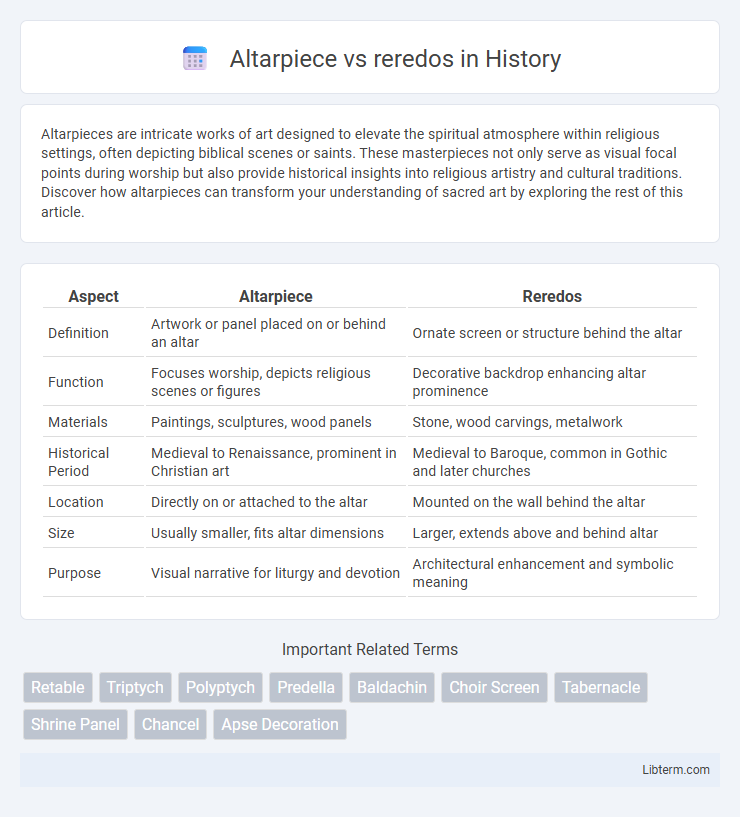Altarpieces are intricate works of art designed to elevate the spiritual atmosphere within religious settings, often depicting biblical scenes or saints. These masterpieces not only serve as visual focal points during worship but also provide historical insights into religious artistry and cultural traditions. Discover how altarpieces can transform your understanding of sacred art by exploring the rest of this article.
Table of Comparison
| Aspect | Altarpiece | Reredos |
|---|---|---|
| Definition | Artwork or panel placed on or behind an altar | Ornate screen or structure behind the altar |
| Function | Focuses worship, depicts religious scenes or figures | Decorative backdrop enhancing altar prominence |
| Materials | Paintings, sculptures, wood panels | Stone, wood carvings, metalwork |
| Historical Period | Medieval to Renaissance, prominent in Christian art | Medieval to Baroque, common in Gothic and later churches |
| Location | Directly on or attached to the altar | Mounted on the wall behind the altar |
| Size | Usually smaller, fits altar dimensions | Larger, extends above and behind altar |
| Purpose | Visual narrative for liturgy and devotion | Architectural enhancement and symbolic meaning |
Introduction to Altarpieces and Reredoses
Altarpieces and reredos are significant architectural and artistic elements in Christian churches, serving to enhance the visual focus behind the altar. Altarpieces are typically painted or sculpted panels directly attached or positioned behind the altar, illustrating religious scenes or figures for liturgical emphasis. In contrast, reredos are larger, often more elaborate structures made of wood, stone, or metal, rising above and behind the altar, sometimes incorporating altarpieces while also including intricate carvings or decorative elements.
Historical Origins and Evolution
Altarpieces originated in the Middle Ages as painted or sculpted panels placed behind the altar, serving as focal points for worship and storytelling through Christian iconography. Reredoses, often more elaborate and architectural with intricate carvings and multiple tiers, emerged during the Gothic and Renaissance periods as ornamental screen-like structures behind altars. Over time, altarpieces evolved from simple panels to complex polyptychs, while reredoses became prominent in cathedrals and large churches, reflecting regional artistic influences and liturgical developments.
Defining Altarpiece: Function and Features
An altarpiece serves as a decorative or narrative panel positioned directly behind or above the altar, often featuring painted or carved religious imagery to enhance worship focus. Its primary function is to visually communicate sacred stories or saints' lives, facilitating devotion and liturgical contemplation. Altarpieces vary in size and complexity, commonly divided into multiple panels, and are integral to church interiors for spiritual and artistic expression.
Understanding the Reredos: Position and Purpose
A reredos is an ornamental screen or decoration placed behind the altar, often extending vertically and richly adorned with sculptures, paintings, or reliefs. It serves as a visual backdrop that emphasizes the sacredness of the altar space, contrasted with an altarpiece which is generally a standalone artwork positioned directly on or just above the altar. The reredos not only enhances liturgical focus but also functions architecturally, integrating religious imagery into the church's structural design.
Artistic Styles and Materials Used
Altarpieces often feature intricate paintings or sculptures made from wood, panel, or canvas, showcasing Renaissance, Baroque, or Gothic artistic styles characterized by detailed figurative representation and vivid color palettes. Reredos typically consist of elaborate architectural structures crafted from carved stone, marble, or metal, reflecting Gothic and Romanesque styles with ornamental niches, columns, and relief work that emphasize verticality and grandeur. Both serve as liturgical focal points but differ in artistic techniques and materials, with altarpieces highlighting pictorial narrative and reredos emphasizing sculptural ornamentation.
Key Differences Between Altarpiece and Reredos
Altarpieces are typically movable artworks or panels placed directly behind the altar, often featuring paintings or sculptures depicting religious scenes. Reredos are fixed architectural structures attached to or rising behind the altar, usually more elaborate and crafted from wood, stone, or metal, incorporating niches, statues, and ornate carvings. The key difference lies in altarpieces being primarily artistic elements while reredos serve as permanent, architectural backdrops enhancing the altar's visual and spiritual impact.
Symbolic and Liturgical Significance
Altarpieces serve as focal points behind the altar, symbolizing divine presence and illustrating biblical narratives to enhance worshippers' spiritual connection during liturgical ceremonies. Reredos, often more architecturally integrated and ornamental, emphasize the sacredness of the altar space by depicting saints, angels, or religious scenes that reinforce doctrinal themes and aid congregational devotion. Both elements play crucial roles in visually communicating theological concepts and elevating the solemnity of the Eucharistic celebration.
Notable Examples Across History
The Ghent Altarpiece by Jan van Eyck stands as a quintessential example of an altarpiece, featuring intricate panels and detailed iconography that revolutionized religious art in the 15th century. In contrast, the reredos of the Cathedral of Santiago de Compostela is renowned for its elaborate sculptural reliefs, serving as a grand architectural backdrop to the altar and exemplifying Gothic art in Spain. Both altarpieces and reredoses have played pivotal roles in ecclesiastical settings, reflecting distinct artistic approaches and cultural contexts throughout history.
Influence on Church Architecture
Altarpieces and reredoses significantly influence church architecture by shaping the visual and spatial focus within the sanctuary. Altarpieces, often painted or sculpted panels, directly enhance the altar's prominence, guiding worshippers' attention during liturgical ceremonies. Reredoses, typically larger and more elaborate, extend vertically and horizontally, integrating with the chancel's design to create a cohesive backdrop that emphasizes the altar's sacred function.
Contemporary Relevance and Adaptations
Altarpieces and reredos continue to influence contemporary religious art and architecture through modern reinterpretations using multimedia, abstract designs, and sustainable materials. Artists integrate traditional iconography with digital technology to create immersive spiritual experiences that resonate with today's congregations. Adaptations emphasize accessibility and engagement, bridging historical symbolism with current artistic trends in worship spaces.
Altarpiece Infographic

 libterm.com
libterm.com